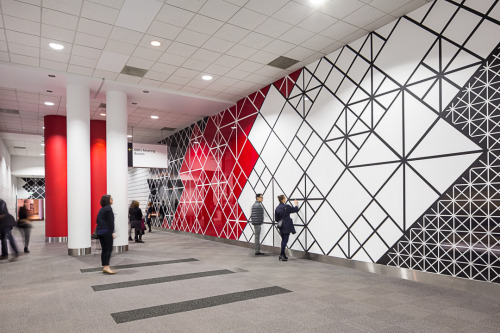What is Site Specific Art?

The Guggenheim Museum defines site-specific art as “an artist’s intervention in a specific locale, creating a work that is integrated with its surroundings and that explores its relationship to the topography of its locale… and to restructure the viewer’s conceptual and perceptual experience of that locale through the artist’s intervention.” Said another way, site-specific art is created with a particular space (i.e. site) in mind vs. typical works that can be exhibited anywhere from the studio to the gallery, museum, home or business. At its most basic, site-specific art transforms an environment into an experience. If that line sounds familiar, you might notice it happens to be our mission here at NINE dot ARTS, a mission we take as seriously as a coronary (but in a good way!)
Lest we confuse you, however, not every artwork we place is site-specific. True, any great (dare we say even a good) piece of art will change any space it’s in. But the difference between a standard (if there is such a thing) piece of art and a site-specific work is its relationship to its surroundings. A site-specific work becomes an integral part of that specific environment rather than something exterior/surface to it. A site-specific work uses the space itself as a medium. Take, for example, Sandra Fettingis’ I Know That You Know That I Know that we commissioned at the Colorado Convention Center, a 160-foot long work made from paint and acrylic that transforms a banal hallway into an optical explosion of black, red and white, geometric shapes and line. She leveraged the walls, the very space and shape of the hallway itself, to create a massive piece that envelopes the viewer: your eyes pulsate at each linear intersection, you can’t help but feel overwhelmed and dazzled as you move through the corridor.
Another example, Samantha Parker Salazar’s Equidistant at the Courtyard Austin – University Area, scales four-stories above the hotel’s reception desk. You may remember Sam from our interview with her about her process for a post this past February. NINE dot ARTS and Sage Hospitality commissioned Samantha to create this site-specific sculpture from a crescendo of intalgio prints, paper, monofilament and paint. The work hovers like a giant, silent waterfall above the check-in desk, viewable from each floor. The viewer’s concept of both the work and the space changes at each viewing level as more of the work is revealed.
From its inception in the late 1960s and early 1970s, site-specific art has challenged art’s reach economically and socio-politically in addition to its perceived limits of scale, space, light and form. Christo and Jeanne-Claude’sproposed temporary site-specific piece, Over the River, for example, will “suspend 5.9 miles of silvery, luminous fabric panels high above the Arkansas River along a 42-mile stretch of the river between Salida and Canon City in south-central Colorado.” The proposed work has pitted environmentalists concerned about big horn sheep, fish and birds against impassioned river rafting companies and local businesses, who stand to make hefty profits during the work’s installation. The work has been steeped in legal battles and scrutinized at the local, state and national levels, including a study by the Bureau of Land Management. The work’s fate now rests in the hands of the U.S. Court of Appeals.
Most often, site-specific art works best at large scales where the viewer can experience the work from different perspectives, conditions and contexts, which means not every space can accommodate a site-specific piece. Additionally, because site-specific work is created for a particular setting, it may take on other forms and meanings in different locales. Conversely, the same locale can be interpreted and intervened upon in myriad ways. Even the same artist can reimagine the same space time and time again through different site-specific works.
Site-specific work is not for the faint of heart. It takes a crazy amount of guts and pure, blind faith to trust an artist with hundreds, if not thousands or tens of thousands, of square feet at her disposal. But, as we’ve discovered, if you turn a space over to an artist, you’ll probably be more than pleasantly surprised, not only awe-struck yourself but also the most enviable art collector around.
“I Know That You Know That I Know” by Sandra Fettingis at Colorado Convention Center, photograph by Paul Brokering
#SiteSpecificArt #COConventionCenter #ArtCourtyardAustin #Christo&JeanneClaude #OverTheRiver